If you have traveled a lot in Spain and the world, as we have, you will be aware that there are countless wonderful places to discover and visit.
Therefore it has not surprised us that in our recent trip through germany We have discovered one of those incredible places.
Specifically I am referring to the city of Erfurt, of which I admit that until we traveled to visit it I was not aware of its cultural and tourist attractions.
What's more, I didn't even know that this city belonged to the ancient German Democratic Republic.
I already tell you that Erfurt is a city with a beautiful historic center, with corners with great charm and a really interesting history.
It is the classic German city with a very nice historic center to visit, all pedestrian, where your walk will only be disturbed by trams and bicycles, and where it will be very easy for you to walk to all the corners that you should know.
Once we have visited it, I am not surprised that it is a very touristy city, since throughout the year it receives thousands of tourists, and where they have admitted to me that in some moments of high season they have problems with excess tourism.
But instead I will tell you that you will not see Spanish tourists, which I now understand, because after discussing it with friends and family, I have not found a person who, at least until now, even knows the existence of Erfurt.
All the information in detail
- 1 Where is Erfurt
- 2 Curiosities of the history of Erfurt
- 3 The best things to see and do when visiting Erfurt in one day
- 3.1 Kramer Bridge (Krämerbrūcke) in Erfurt
- 3.2 Old Synagogue and Treasury of Erfurt
- 3.3 Gothic Cathedral of Saint Mary
- 3.4 Church of St. Severus in Erfurt
- 3.5 Fish Market Square
- 3.6 Petersberg Citadel, great fortress in Erfurt
- 3.7 Andreasstrasse Memorial and Educational Center, the traces of the GDR
- 3.8 Egapark, large gardens in Erfurt
Where is Erfurt
At the outset I will tell you that Erfurt is capital of the state of Thuringia, with 214.000 inhabitants today, which is located about 90 km from the former border between West Germany and the GDR.
Curiosities of the history of Erfurt
Its history is marked by its great rise in Jewish community in the Middle Ages, time in which Erfurt It had about 20.000 inhabitants and was the fifth city in the then Holy Roman German Empire, antecedent of today's Germany.
This historical boom is also facilitated by being located in the geographical center of the territory, in the axis where the the Camino de Santiago and Salt Road.
Furthermore, she was the only city of europe, along with the French Toulouse, where what was known as “pastel dye“, which was extracted from a plant with yellow flowers and with which the fabrics were dyed a deep and indelible blue color.
Another historical landmark of the city of Erfurt was the presence of Martin Luther, at a key time in his life, and where he arrived in 1501 at the age of 17 to study civil law.
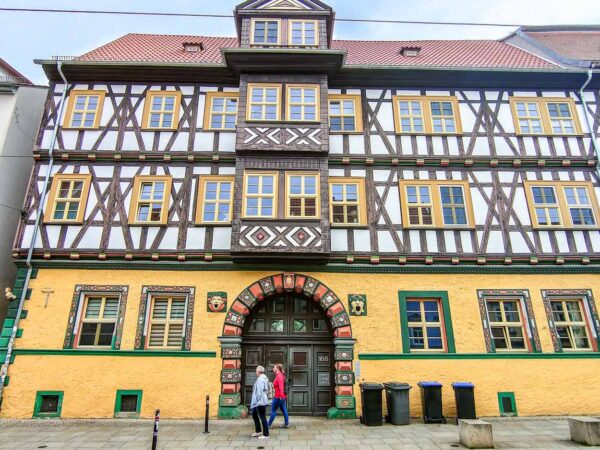
At that time in Erfurt was found oldest university in Germany, founded in 1379, where knowledge of philosophy, medicine, law, and theology was taught.
It was, along with the University of Bologna, the only place where civil law could be studied since in the rest of the universities it was only possible to study ecclesiastical law, a subject that Martin Luther studied next.
But in 1505 a traumatic event, struck by lightning during a storm, led him to enter a Augustinian monastery in Erfurt where he became a monk in 1507.
Looking ahead to your visit, it is also worth noting that during the Second World War Only 15 percent of the city was destroyed, which has allowed preserve a large number of medieval houses and heritage buildings.
And, finally, another historical aspect that will also mark your Erfurt visit They are the traces of his belonging to the German Democratic Republic.

The best things to see and do when visiting Erfurt in one day
In order to plan the highly recommended visit, we are going to highlight the main places that you should visit.
Kramer Bridge (Krämerbrūcke) in Erfurt
From a tourist point of view, you will see that the most characteristic image of Erfurt is that of the architectural complex that forms its Cathedral of Saint Mary and the church of Saint Severus.
But I can tell you that the place that has impressed us the most is, without a doubt, the Kramer Bridge, and we tell you our experience.
ORGANIZE your TRIP
- Don't forget your TRAVEL INSURANCE with a 5% discount
- Book the HOTEL for your trip
- RENT a CAR for your trip
- The best TOURS and EXCURSIONS in Spanish
- NO-LINE TICKETS for museums and monuments
- Best FREE TOURS around the world
- Book your TRANSFER from the airport
- eSIM card with INTERNET at the best price
To visit the city, here you can sign up for a guided tour of Erfurt two hours long, with different alternatives, including a guide in spanish
We were staying in the very central hotel and we knew that Erfurt had a very interesting bridge.
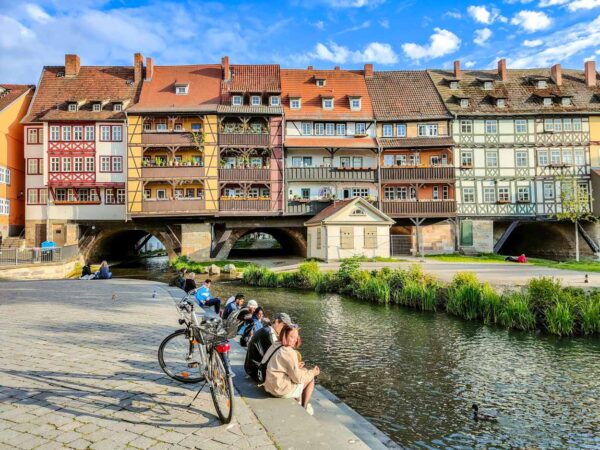
From our hotel located east of the historic center we arrive at the Wenigemarkt square, where there is a stone church with a tower under which a pedestrian arch opens.
We decided to cross through that arch because we saw that it led to a narrow street with houses decorated with colorful facades.
This street is a succession of small design, craft, clothing and cafe shops, until we reach the end of it, and contrary to what was indicated to us Google Maps, we had not seen the bridge.
Then we saw that there was a very narrow alley with some stairs going down and we decided to enter it.

And suddenly we arrived at the banks of a river surrounded by trees and in front of us, the bridge.
Indeed, we realized that we had been walking along the bridge, which is characterized by the houses that follow each other on both sides of it.
El Kramer Bridge: Merchants Bridge, was built in 1325 on the site of an old wooden bridge, with characteristics similar to the famous Vecchio Bridge in Florence, and currently it is the longest bridge in Europe with inhabited houses about him.
Measuring 120 meters in length, the bridge was built with churches on each side, of which only the one in Agidien, through whose arch we access it.
Initially it had 62 very narrow houses that have subsequently been combined, so that there are now 32 inhabited houses, all of them municipal property; You can still see some of those narrow houses.
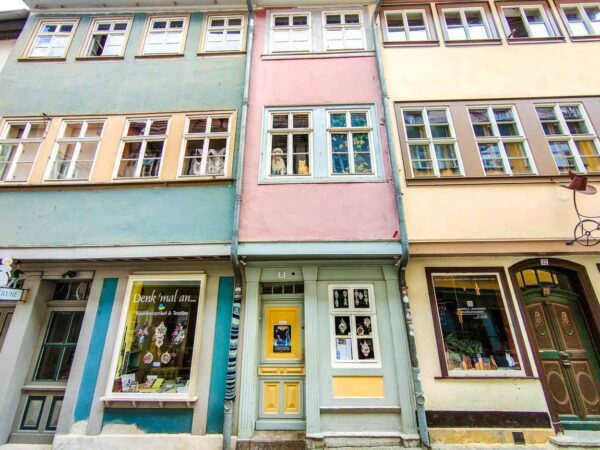
Old Synagogue and Treasury of Erfurt
Right next to the bridge and on the banks of the river you can see a mikveh, instead of jewish ritual bath, which was found in the summer of 2007.
But, without a doubt, the best vestige of the presence of the Jewish community in Erfurt is Old Synagogue, one of the few surviving medieval synagogues and the oldest in Europe to have been preserved with the complete building.
Its origin dates back to a building from the year 1084, but after being burned, the current synagogue was built in 1279.
Now it is a museum that you can visit and where you will learn that in 1349 the Jewish community suffered a massacre in Erfurt after being accused of bringing the plague.
Although 50 years later they returned to the city, finally at the end of the XNUMXth century they were expelled this time.
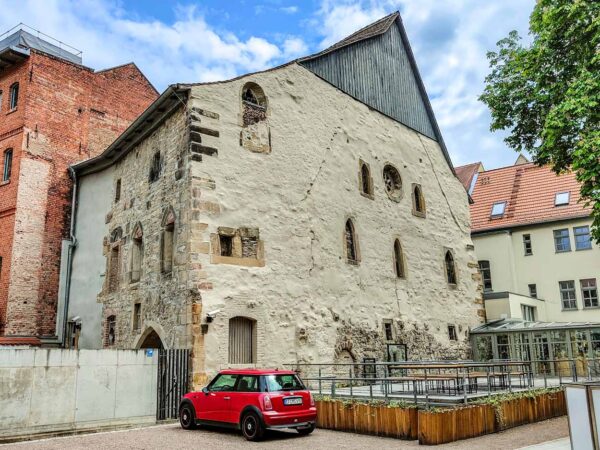
Over the years, the building became a warehouse and was overlapped by other buildings, so it was not known that the old synagogue was located there.
In the lower part of the stone wall an area of the original 11th century synagogue.
But the highlight of the visit without a doubt is being able to see what is known as Erfurt Treasury.
Don't forget your Travel Insurance
Are you organizing your trip or getaway? Don't leave without take out your travel insurance before, and here we explain why. If you hire it with us, you have a 5% discount
It is a true treasure of a rich Jew that was found in 1990 in the basement of a building from the late XNUMXth century.
It consists of more than 28 kilos of objects and jewels that have an incredible value, among which, for example, include eight glasses of the Middle Ages, of the 17 that still have these characteristics in the world.
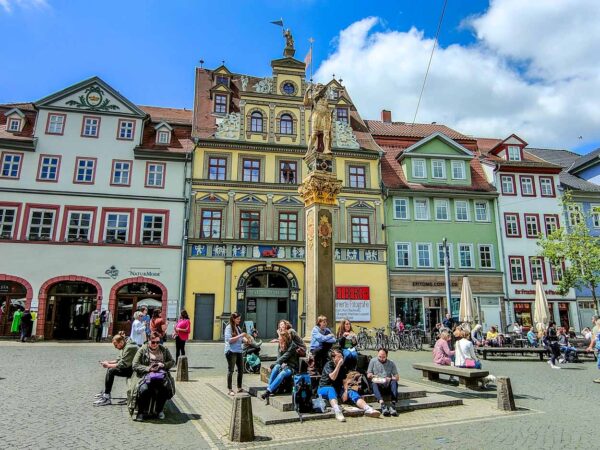
Also a huge gold wedding ring with an estimated value at the time of 11 million euros, and, likewise, 3.141 silver coins of French francs originating from the French city of Tours, all of which you can see during your museum visit.
Now a community of about 800 Jews lives in Erfurt.
And it is precisely this Jewish heritage, the ancient synagogue, its treasure and the mikvah medieval, the reason why Erfurt has requested the declaration of Heritage to UNESCO.
Gothic Cathedral of Saint Mary
We have already commented that the whole of the Cathedral of Santa María and the church of San Severo is the emblematic image of Erfurt.
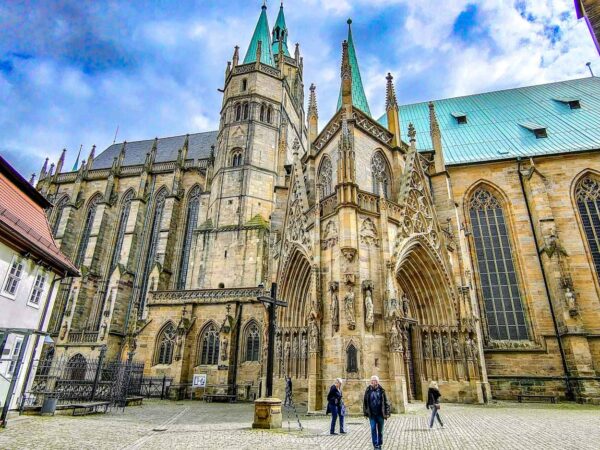
To reach these two buildings you must climb a long staircase of 70 steps.
To the left is the cathedral, whose original building was founded in 742 to become the main church of the diocese of Erfurt.
It has a very peculiar interior because shortly after being built, due to its location at the top of a hill, part of the central nave collapsed, which is why the architectural difference between the choir area and the other is striking. church area.
In the building, the Romanesque tower, late gothic west hallAs well as gothic stained glass of the choir and the original 14th century seating.
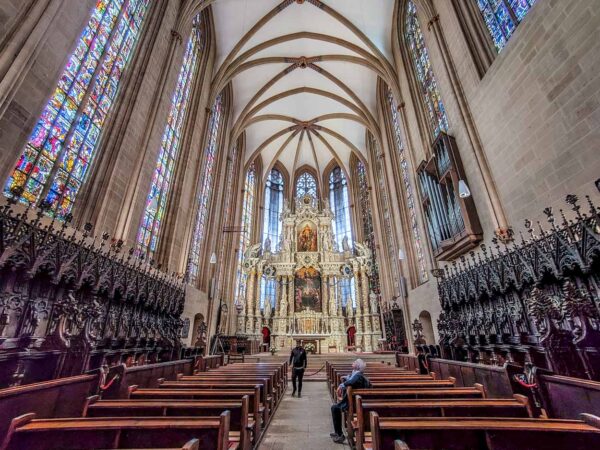
As a curiosity, you can see a large romanesque chandelier from the 850th century, which looks modern due to its design, but is actually more than XNUMX years old.
Here you have more information for visit Erfurt Cathedral with guided tour schedules and prices.
Church of St. Severus in Erfurt
La Catholic Church of San Severo It has its origins in a collegiate church of a canon community from the 12th century.
Its interior has five Gothic-style naves and there is the saint's tomb, which dates back to 1365.
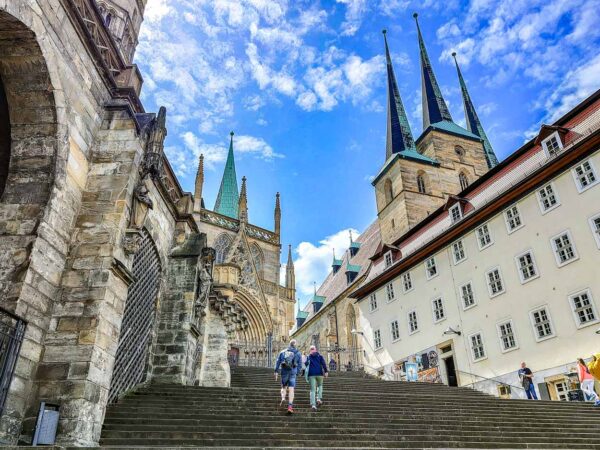
Fish Market Square
El heart of the historic center of Erfurt is Fish Market Square.
Book your hotel, 15% discount, free cancellation
When planning your trip, we advise you to, well in advance, Book your hotel now on booking.com where you can find discounts from 15% and you will have a possible cancellation for free
There stands out the City Hall negotiator building which was built in 1874, although its origins date back to the XNUMXth century.
Inside you can see murals with legends and scenes from Luther's life.
Two houses with a similar architectural style will also catch your attention in the square.

One of the houses, from 1892, has a historicist style façade, unpainted, which is similar to the neighboring house that is 300 years older and shows a façade with great colorful decoration.
Petersberg Citadel, great fortress in Erfurt
Next to the cathedral complex and the church of San Severo is the St. Peter's Hill and above, extends the Petersberg Citadel.
Is one of the largest and best preserved fortresses in Central Europe, with a star-shaped wall and eight bastions.
You can access it for a panoramic elevator that takes you to a glass platform which performs the functions of gazebo, and from where you have the best panoramic views of Erfurt.
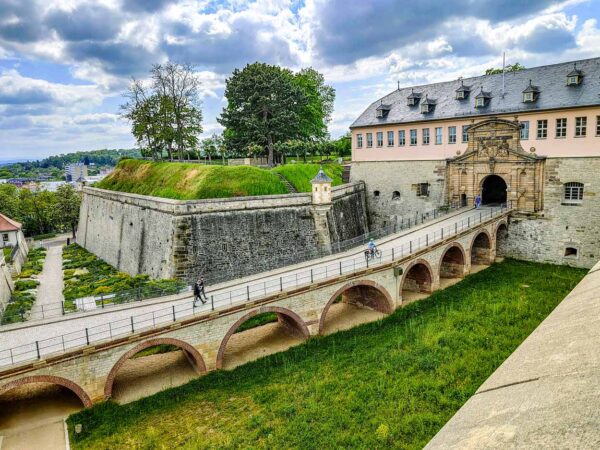
In this large space rebuilt at the end of the last century, you find the building of what was once a old Romanesque style church 850 years ago, which was destroyed in a battle at the time of Napoleon between the French and the Prussians.
Nowadays it is a great temporary exhibition hall.
Andreasstrasse Memorial and Educational Center, the traces of the GDR
At the foot of the fortress you find one of the most interesting corners to discover the history of erfurt.
Reserve your RENTAL CAR now for your trip
Looking ahead to your trip, book your rental car now on this website that offers you the best price guaranteed and allows you a possible free cancellation in most cases. Here you have more information with tips for renting a car
This is the Andreasstrasse Memorial and Educational Center which occupies what was a prison and Justice building during the Weimar Republic.
From 1952 to 1989, in addition to being a general prison, it became a jail of the Stasi, political police of the GDR.

During the guided tour, which can be done with an audio guide on your mobile phone, you will visit three floors of the old prison, distributed under the motto “Detention, Dictatorship and Revolution, from 1949 to 1989”.
The visit begins with the floor dedicated to preventive detentions carried out by the Stasi, and during it you tour various isolation cells or the showers, while they tell you how political prisoners were treated.
In this prison there were only preventive political prisoners, men and women, who when they were convicted, already went to prisons where they mixed with criminals.
In the plant dedicated to the dictatorship, through comics It tells what the power of the party was with themes such as propaganda, the planned economy, art or literature.
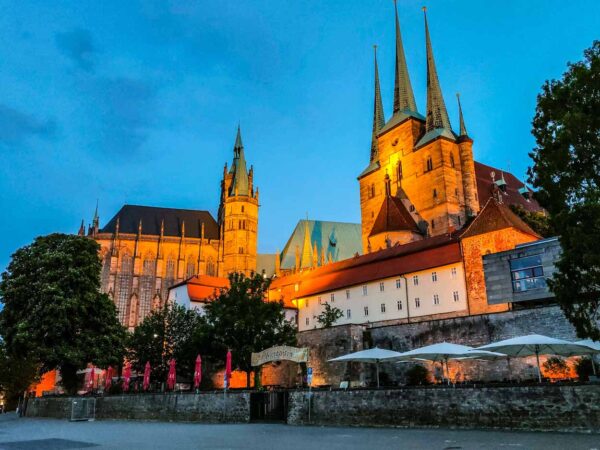
It will catch your attention room dedicated to Stasi, all wrapped in an environment that will remind you of the movie "Other people's lives".
The first floor is dedicated to what is known as Peaceful Revolution in Thuringia and the german reunification.
This movement that began in 1978 with the Prayers for Peace, it expanded especially in Leipzig and Berlin.
One aspect that is delved into during the visit is the amnesty of political weights that was decreed in October 1989, and the new Travel Law which on November 9, 1989 resulted in the fall of the Berlin Wall.
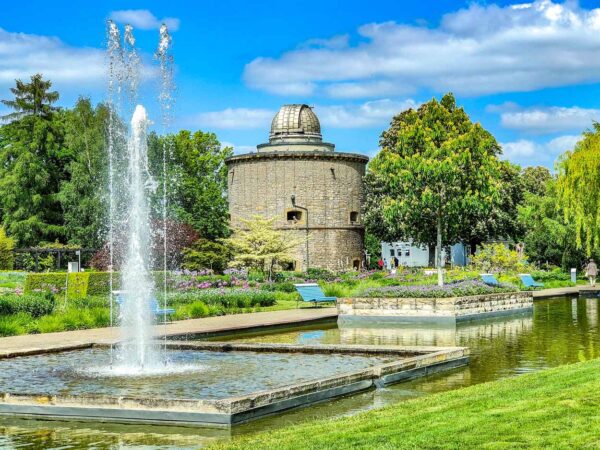
Egapark, large gardens in Erfurt
If you have time during your visit to Erfurt and want to discover a corner of nature, from the center you can take the tram to the Egapark.
It is what was the most important park with gardens in the 60s in Germany.
During your walk through this large area with large meadows where different pavilions are arranged, in spring you will be able to see the largest ornamental flower bed in Europe, a rose garden or a typical Japanese garden.


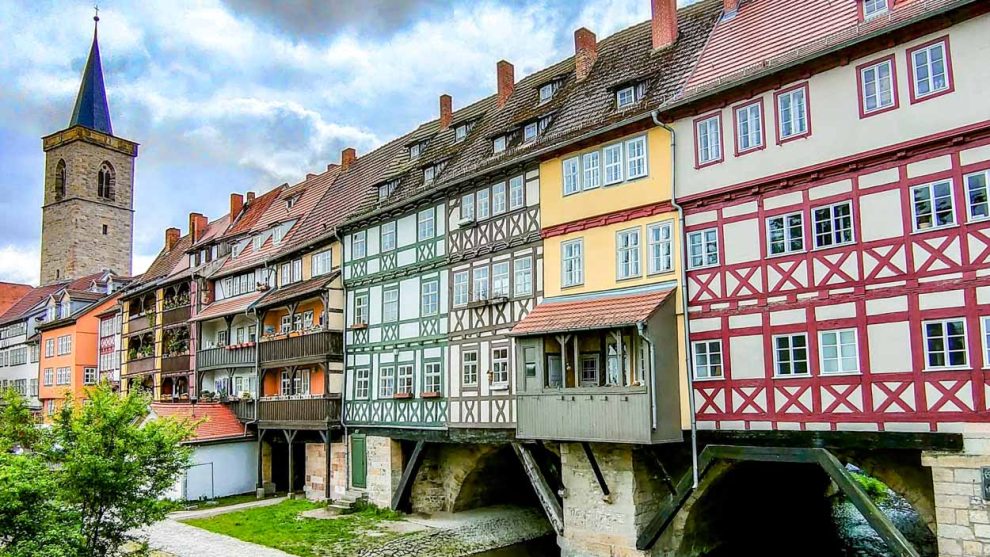
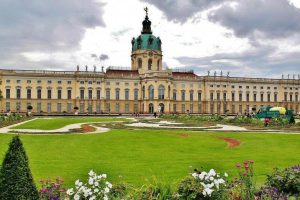
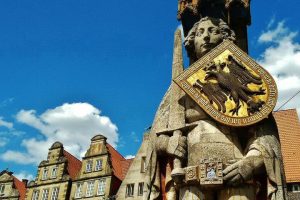












Comment